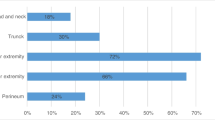Abstract
Background
In the developing world, the incidence of electrical injuries has increased in the past few years. Electrical injuries represent approximately 5 % of all burn admissions to burn units in the United States.
Objective
The objective of this study is to understand the causes of electrical burns in our population, sex, age, duration of treatment, distribution of electrical burns by season, accompanying other traumatic injuries with electrical burns, entry lesions of high-voltage electrocution, location of injuries, the methods of treatment, duration of treatment, and mortality.
Materials and methods
This is a retrospective study that included 246 patients with electrical burns treated in the 2005–2010 period at the Department of Plastic and Reconstructive Surgery in Kosovo. The data were collected and analyzed from the archives and protocols of the University Clinical Center of Kosovo. Data processing was done with the statistical package InStat 3. From the statistical parameters the structural index, arithmetic median, and standard deviation were calculated. Data testing was done with the χ2 test and the differences were considered significant if p < 0.05.
Conclusion
The high mortality, 9.1 %, and 7 patients (10.6 %) transferred out of our country for treatment is a reflection of the lack of a burn center in our department.





Similar content being viewed by others
References
Patil SB, Khare NA, Jaiswal S, Jain A, Chitranshi A, Math M. Changing patterns in electrical burn injuries in a developing country: should prevention programs focus on the rural population? J Burn Care Res. 2010;31(6):931–4.
Kidd M, Hultman CS, Van Aalst J, Calvert C, Peck MD, Cairns BA. The contemporary management of electrical injuries: resuscitation, reconstruction, rehabilitation. Ann Plast Surg. 2007;58:273–8.
Lee RC. Injury by electrical forces: pathophysiology, manifestations, and therapy. Curr Probl Surg. 1997;34:677–764.
Esselman PC, Thombs BD, Magyar-Russell G, Fauerbach JA. Burn rehabilitation: state of the science. Am J Phys Med Rehabil. 2006;85:383–418.
Muir IFK. The management of electrical burns. Postgrad Med J. 1957;33:219–23.
Koumbourlis AC. Electrical injuries. Crit Care Med. 2002;30(11 Suppl):S424–30.
Chasmar LR. Electrical burns. Can Med Assoc J. 1967;97:453–8.
Dzhokic G, Jovchevska J, Dika A. Electrical injuries: etiology, pathophysiology and mechanism of injury. Maced J Med Sci. 2008;1(2):54–8.
Arnoldo B, Klein M, Gibran NS. Practice guidelines for the management of electrical injuries. J Burn Care Res. 2006;27(4):439–47.
Vazquez D, Solano I, Pages E, Garcia L, Serra J. Thoracic disc herniation, cord compression, and paraplegia caused by electrical injury: case report and review of the literature. J Trauma. 1994;37:328–32.
Chandra NC, Siu CO, Munster AM. Clinical predictors of myocardial damage after high voltage electrical injury. Crit Care Med. 1990;18:293–7.
Arrowsmith J, Usgaocar RP, Dickson WA. Electrical injury and the frequency of cardiac complications. Burns. 1997;23:576–8.
Arnoldo BD, Purdue GF, Kowalske K, Helm PA, Burris A, Hunt JL. Electrical injuries: a 20-year review. J Burn Care Rehabil. 2004;25:479–84.
Lee J, Sinno H, Perkins A, Tahiri Y, Luc M. 14,000 volt electrical injury to bilateral upper extremities: a case report. McGill J Med. 2010;13(1):18–21.
Mohammadi AA, Amini M, Mehrabani D, Kiani Z, Seddigh A. A survey on 30 months electrical burns in Shiraz University of Medical Sciences Burn Hospital. Burns. 2008;34:111–3.
Acosta AS, Azarcon-Lim J, Ramirez AT. Survey of electrical burns in Philippine General Hospital. Ann N Y Acad Sci. 1999;888:12–8.
Nursal TZ, Yildirim S, Tarim A, Caliskan K, Ezer A, Noyan T. Burns in southern Turkey: electrical burns remain a major problem. J Burn Care Rehabil. 2003;24(5):309–14.
Jeng JC, Fidler PE, Sokolich JC, Jaskille AD, Khan S, White PM, Street JH 3rd, Light TD, Jordan MH. Seven years’ experience with integra as a reconstructive tool. J Burn Care Res. 2007;28(1):120–6.
Buja Z, Arifi H, Hoxha E. Electrical burn injuries. An eight-year review. Ann Burns Fire Disasters. 2010;23(1):4–7.
Akçan R, Karacaoğlu E, Keten A, Odabaşi AB, Kanburuoğlu C, Tűmer AR, Alkurt-Alkan A. Electrical fatalities in Ankara over 11 years. Turk J Med Sci. 2012;42(3):533–8.
Acknowledgments
We thank the archive and all the staff of the Department of Plastic Surgery for their technical support.
Conflict of interest
S. B. Duci, H. M. Arifi, H. R. Ahmeti, M. E. Selmani, Z. A. Buja, M. M. Gashi, V. K. Zatriqi and A. Y. Mekaj declare no financial and personal relationships with other people or organizations that could inappropriately influence (bias) their work. All authors read and approved the final manuscript.
Ethical standards
This article does not contain any studies with human or animal subjects performed by any of the authors.
Author information
Authors and Affiliations
Corresponding author
Rights and permissions
About this article
Cite this article
Duci, S.B., Arifi, H.M., Ahmeti, H.R. et al. Electrical burn injuries of 246 patients treated at the University Clinical Center of Kosovo during the period 2005–2010. Eur J Trauma Emerg Surg 40, 679–685 (2014). https://doi.org/10.1007/s00068-014-0379-6
Received:
Accepted:
Published:
Issue Date:
DOI: https://doi.org/10.1007/s00068-014-0379-6




